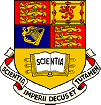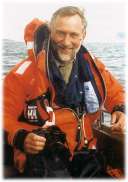
 |
|
News Page |

January 2001 |
This month's news stories:NERC Chief Executive visits SPATESA Mission to Mercury |
 NERC Chief Executive Visits SPAT
NERC Chief Executive Visits SPATOn November 28th Professor John Lawton, the Chief Executive of the Natural Environmental Research Council (NERC) visited the atmospheric side of SPAT as part of a whistle-stop tour of several departments at Imperial College. Since NERC provides funding for many of the research activities within the group one of the main aims of the visit was to check that their money was being well spent! In addition, Professor Lawton was especially keen to meet with the research students to discuss their particular needs.
After a brief introduction to the group by John Harries, several short presentations detailing the exciting science being done within the group were given. Topics covered included a novel method to operationally detect thin cirrus cloud, signatures of climate change contained within high resolution radiance spectra, evidence to suggest a solar cycle forcing of ozone amounts and variability, modelling studies to investigate the effects of forcing tropical winds on the northern hemisphere state, and the impact of an improved parameterisation of stratospheric heating rates on the global circulation. The visit also afforded Professor Lawton the opportunity to visit the Earth Observation Calibration Facility (EOCF), primarily funded by NERC, and see a demonstration of the methodology used to calibrate the GERB instrument.
One area that seemed to particularly catch Professor Lawton's attention involved research on the idea of persistence and scaling within meteorological data, either for the purpose of predicting extreme rainfall events (Ashley Tomsett), or in pricing weather derivatives (Jo Syroka). Subject to approval by the Department of Trade and Industry, both may be invited to give a presentation on their work during National Science Week in March 2001.
It appears Professor Lawton appreciated the efforts of all the group members in exhibiting and discussing their work, having 'enjoyed the visit and learned a lot'.
Helen Brindley 14th December 2000
 |
ESA's BepiColombo mission was named after a distinguished Italian scientist who first solved the puzzle of why Mercury turns exactly three times around its axis while it orbits the Sun twice. The mission will consist of three elements a Planetary Orbiter, a Magnetospheric Orbiter, and a Surface Element that will land on Mercury. The picture shows an artist's impression of the BepiColombo Planetary Orbiter over the sunlit face of the planet. |
The European Space Agency's Planetary Cornerstone Mission to Mercury, recently approved for a launch in 2009, was born from a mission proposal submitted to the European Space Agency in May 1993 by an international team of scientists led by André Balogh. Since 1993, several mission feasibility studies have been conducted by ESA, under the guidance of a Science Advisory Group. It isn't easy to get to Mercury, and once there, the environment is very hostile for spacecraft, swinging from extremely hot to extremely cold. This is the reason why it was visited by only one spacecraft before, NASA's Mariner 10, in 1974-75. Mercury may be a small planet, not much bigger than our Moon, but it holds some of the key information that will help us to understand how the terrestrial planets, including the Earth, were formed. In particular, Mariner 10 found an unexpected magnetic field around Mercury that is of great interest to our group. Mercury's magnetic field is expected to shed some light on the puzzling interior of the planet; it also generates a small but dynamic magnetosphere around it.
Now that our efforts for initiating a mission to Mercury have been successful, we are readying ourselves to take a major part in it. Dr. Giacomo Giampieri has been awarded a fellowship by ESA to work in our group on the relationship between Mercury's magnetic and gravitational fields. We expect that our research on this topic will help ensure that the scientific objectives of this important mission will be met in full. Preliminary results will be presented at the Royal Astronomical Society's meeting on Mercury on 12 January.
André Balogh 4th January 2001
View November's news, older news or return to Space and Atmospheric Physics home page